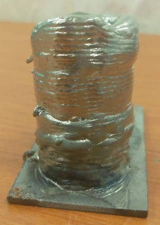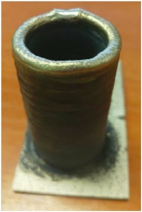In Perm, the quality of 3D products has been improved.
The article was published in the journal "Electrical Engineering, Information Technologies, Control Systems." The research was conducted as part of the strategic academic leadership program "Priority 2030."
The 3D printing in industry is carried out by a robotic manipulator. The programmable logic controller (PLC) sends the necessary commands to the control system to regulate its operation. The main function of the mechanism is the continuous supply of the required volume of wire from the accumulator at the necessary speed, which is managed by the PLC.
Scientists from Perm Polytechnic analyzed the metal 3D printing process and identified the key factors that reduce product quality. The first factor is the deformation of the wire in the insulating channel (the tube that holds the material within the printing zone), which leads to a decrease in the frequency of its contact with the deposited surface. The second factor is layer height shifts due to uneven distribution of impacts on the molten material, causing inhomogeneity and defects. The third factor is the change in linear energy, which refers to the energy expended per length of the weld seam during metal melting. This change increases the wear of moving mechanisms and printer components. For each issue, the polytechnicians proposed a constructive solution.
The accumulation of wire in the insulating channel can be mitigated by relocating the feeding motor with rollers closer to the accumulator and adding an additional compensation motor. This will reduce the risk of overstrain and stabilize the printing process. The implementation of this method requires the installation of a filling sensor for process automation and improved system efficiency.

"In additive manufacturing, stoppages for process reconfiguration and changes in conditions are unacceptable. The properties of the formed materials are extremely sensitive to the parameters of thermal cycles. For instance, when producing parts from titanium alloy VT6, failure to maintain stable cooling rates can result in a loss of material strength of up to 100 MPa and a decrease in plasticity by up to 10 percent," says Dmitry Trushnikov, Associate Professor of the "Welding Production, Metrology, and Materials Technology" department at PNIPU, Doctor of Technical Sciences.

"To minimize the impact on the material and layer height shifts, we recommend implementing a control system with artificial intelligence. AI will automatically optimize the deposition parameters based on data about the surface structure (regulating temperature, material feeding speed, etc.). It is necessary to install cameras for precise identification of defect origins and their correction in subsequent layers. Regarding the change in linear energy, this issue requires the use of temperature sensors for automatic regulation of production parameters," comments Igor Bezukladnikov, Associate Professor of the "Automation and Telemechanics" department at PNIPU, Candidate of Technical Sciences.
The solutions proposed by the PNIPU scientists contribute to the development of more reliable and precise metal 3D printing systems, enhancing the efficiency of production processes and product quality. The results obtained can increase the competitiveness of companies and stimulate innovative changes in the field of domestic production of metal parts.